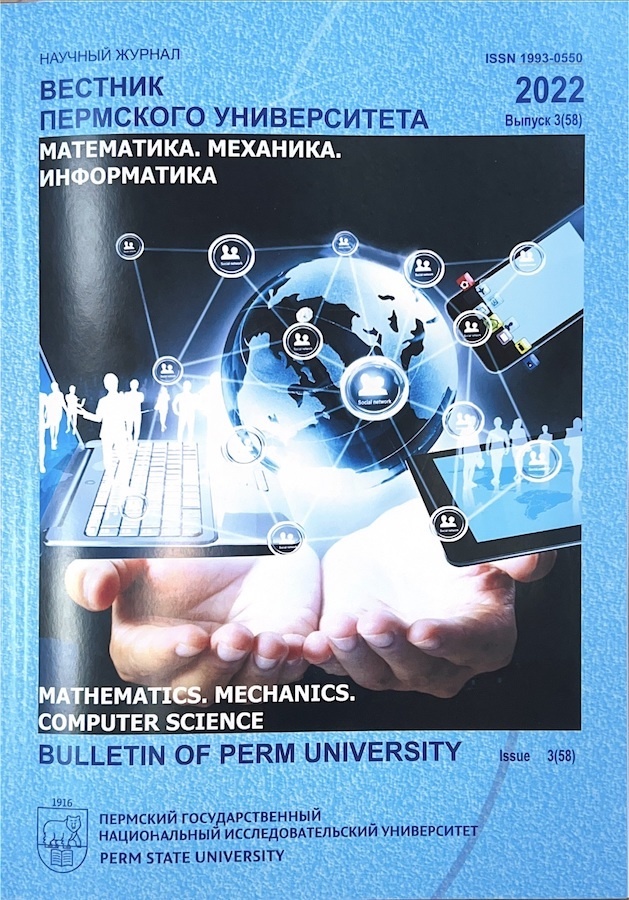Nanometer-scale Bodies Mechanical Interaction Mathematical Model
- Autores: Izyumov R.I.1, Svistkov A.L.1
-
Afiliações:
- Institute of Continuous Media Mechanics, Ural Branch of RAS
- Edição: Nº 4 (67) (2024)
- Páginas: 35-45
- Seção: Mechanics
- URL: https://journal-vniispk.ru/1993-0550/article/view/307291
- DOI: https://doi.org/10.17072/1993-0550-2024-4-35-45
- ID: 307291
Citar
Texto integral
Resumo
Atomic force microscopy (AFM) is based on registration of the interaction of the AFM probe with the sample. A new mathematical model has been developed for the interpretation of experimental data. The relevance of the work is caused by the need to correctly account for the effects that arise in the interaction of bodies at the nanoscale under conditions of large deformations. Standard models (Deryagin-Muller-Toporov (DMT), Johnson-Kendall-Roberts (JKR), etc.) represent a modification of the Hertz model, whose assumptions are not always correct for specific cases. The new model takes into account the curvilinearity of the interface between the probe and the material. Also in the process of model construction the disappearance and appearance of new nonlinear contact surfaces and the corresponding change of surface tension energy were taken into account, which plays an important role in indentation of soft materials (polymers, biological tissues). The results of testing the developed model on experimental data of nanoindentation showed its ability to describe with high accuracy the effects accompanying the contact and the indentation process: a jump-like retraction of the probe into the sample under the influence of surface effects, sticking of the probe at its removal from the sample, and the moment of probe detachment from the sample. A comparison of the obtained model with the results given by the standard DMT and JKR models was carried out. It has demonstrated the greater flexibility of the new model and its ability to describe the experimental data more accurately.
Palavras-chave
Sobre autores
R. Izyumov
Institute of Continuous Media Mechanics, Ural Branch of RAS
Autor responsável pela correspondência
Email: izumov@icmm.ru
junior researcher 1, Academica Koroleva St., Perm, Russia, 614018
A. Svistkov
Institute of Continuous Media Mechanics, Ural Branch of RAS
Email: svistkov@icmm.ru
doctor of physical and mathematical sciences, head of the laboratory of micromechanics of structurally inhomogeneous media 1, Academica Koroleva St., Perm, Russia, 614018
Bibliografia
- Derjaguin, B.V., Muller, V.M. and Toporov, Y.P.: Effect of contact deformations on the adhesion of particles. J. Col Interface Sci 53(2), 314–26 (1975).
- Greenwood, J.A., Johnson, K.L., 1998. An alternative to the Maugis model of adhesion between elastic spheres. J. Phys. D: Appl. Phys. 31, 3279–3290.
- Johnson K.L., Kendall K., Roberts A.D. Surface energy and the contact of elastic solids, Proc. R. Soc. A 324 (1558) (1971) 301–313.
- Maugis D. Adhesion of spheres. The JKR-DMT transition using a Dugdale model, 1992, J. Col and Interface Sci, Vol. 150, no. 1, 243-269.
- Sneddon I.N. The relation between load and penetration in the axisymmetric boussinesq problem for a punch of arbitrary profile, 1965, Int. J. of Eng. Sci. Vol. 3, pp. 47-57.
- Hertz H., 1881. On the contact of elastic solids. J. Reine Angew. Math. 92, 156–171.
- Muller, V.M., Yushenko, V.S., Derjaguin, B.V., 1980. On the influence of molecular forces on the deformation of an elastic sphere and its sticking to s rigid contact. J. Colloid Interface Sci. 77, 91–101.
- Greenwood, J.A., Johnson, K.L., 1981. The mechanics of adhesion of viscoelastic solids. Philo. Mag. 43, 697–711.
- Kim, K.S., McMeeking, R.M., Johnson, K.L., 1998. Adhesion, slip cohesive zone and energy fluxes for elastic spheres in contact. J. Mech. Phys. Solids 46, 243–266.
- Morrow, C., Lovell, M., Ning, X., 2003. A JKR-DMT transition solution for adhesive rough surface contact. J. Phys. D: Appl. Phys. 36, 534–540.
- Chen, S., Yan, C., Zhang P., Gao H.. Mechanics of adhesive contact on a power-law graded elastic half-space. J. of the Mech and Physics of Solids 57 (2009), 1437–1448.
- Zhang X., Wang Q. J., Wang Y., Wang Z., Shen H., Liu J. Contact involving a functionally graded elastic thin film and considering surface effects. Int. J. of Solids and Structures 150 (2018) 184–196.
- El-Borgi S., Comez I., A Receding Frictional Contact Problem between a Graded Layer and a Homogeneous Substrate Pressed by a Rigid Punch. Mech Mat 114 (2017) 201–214.
- Yilmaz K.B., Comez I., Yildirim B., et. al. Frictional receding contact problem for a graded bilayer system indented by a rigid punch. Int. J. Mech Sci141 (2018) 127–142.
- Uzhegova N.I.; Svistkov A.L.; Lauke B. The influence of capillary effect on atomic force microscopy measurements. Int. J. Eng Sci. 2014. Vol. 75. P. 67-78.
- Li X. and Mi C. Effects of surface tension and Steigmann–Ogden surface elasticity on Hertzian contact properties / Int. J. Eng Sci 145 (2019) 103165.
- Weike Y., Wang G. Cylindrical indentation of an elastic bonded layer with surface tension. Applied Mathematical Modelling 65 (2019), 597–613.
- Izyumov, R.I., Svistkov, A.L.: Effect of surface tension forces on changes in the surface relief of the elastomer nanocomposite. Nanosci. Technol. Int. J. 10(1), 51–66 (2019).
- Style, R.W., et. al.: Surface tension and contact with soft elastic solids. Nat. Commun. 4, 2728–2733 (2013).
- Marshall, J.S., Li, Sh.: Adhesive particle flow: a discrete-element approach. Cambridge University Press, New York (2014).
Arquivos suplementares









